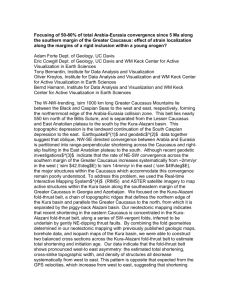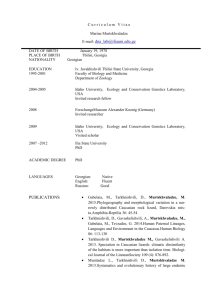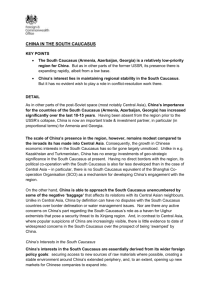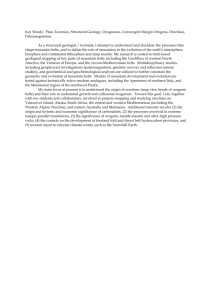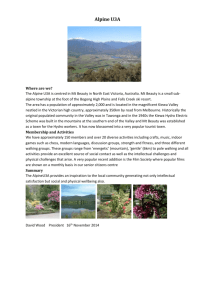Remote sensing approach for the thematic mapping and physical
advertisement
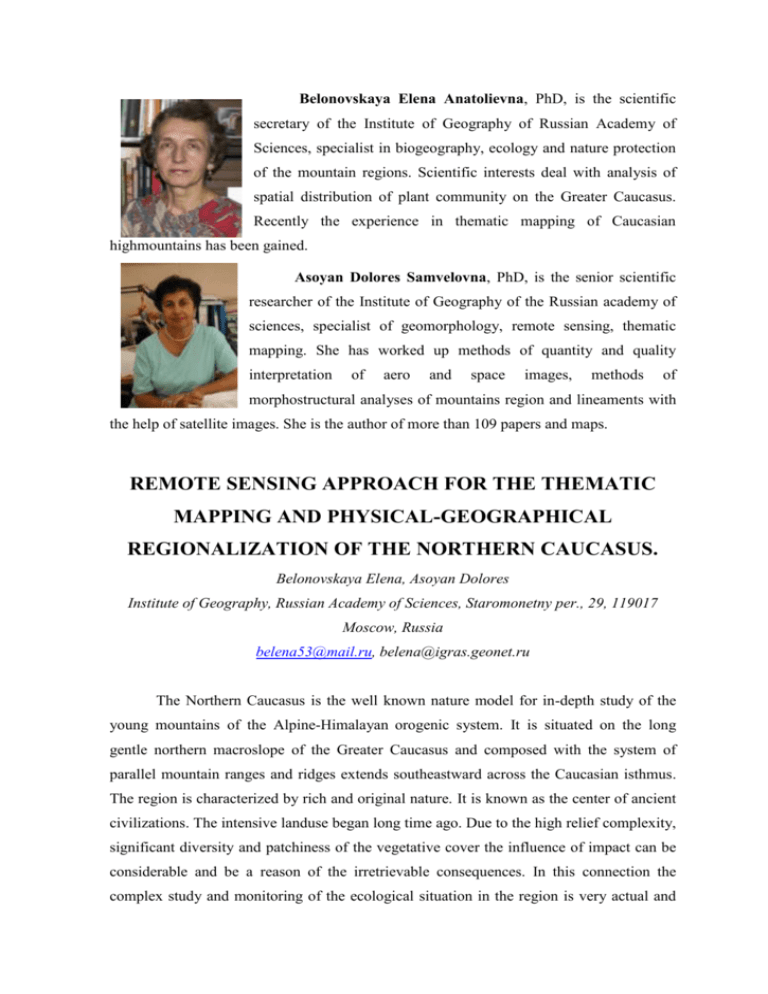
Belonovskaya Elena Anatolievna, PhD, is the scientific secretary of the Institute of Geography of Russian Academy of Sciences, specialist in biogeography, ecology and nature protection of the mountain regions. Scientific interests deal with analysis of spatial distribution of plant community on the Greater Caucasus. Recently the experience in thematic mapping of Caucasian highmountains has been gained. Asoyan Dolores Samvelovna, PhD, is the senior scientific researcher of the Institute of Geography of the Russian academy of sciences, specialist of geomorphology, remote sensing, thematic mapping. She has worked up methods of quantity and quality interpretation of aero and space images, methods of morphostructural analyses of mountains region and lineaments with the help of satellite images. She is the author of more than 109 papers and maps. REMOTE SENSING APPROACH FOR THE THEMATIC MAPPING AND PHYSICAL-GEOGRAPHICAL REGIONALIZATION OF THE NORTHERN CAUCASUS. Belonovskaya Elena, Asoyan Dolores Institute of Geography, Russian Academy of Sciences, Staromonetny per., 29, 119017 Moscow, Russia belena53@mail.ru, belena@igras.geonet.ru The Northern Caucasus is the well known nature model for in-depth study of the young mountains of the Alpine-Himalayan orogenic system. It is situated on the long gentle northern macroslope of the Greater Caucasus and composed with the system of parallel mountain ranges and ridges extends southeastward across the Caucasian isthmus. The region is characterized by rich and original nature. It is known as the center of ancient civilizations. The intensive landuse began long time ago. Due to the high relief complexity, significant diversity and patchiness of the vegetative cover the influence of impact can be considerable and be a reason of the irretrievable consequences. In this connection the complex study and monitoring of the ecological situation in the region is very actual and takes on special significance. That is why thematic mapping, the main aim of which to reveal the relationship between the spatial heterogeneity of plant communities and environmental factors (climatic and geomorphologic) in the Northern Caucasus, is very essential and will help to solve the problem of the environment evaluation and working-out of the recommendations on the sustainable development of the region. Traditionally the Northern Caucasus is divided into three regions: the Western, Central and Eastern Caucasus. The border between the Western and the Central parts passes along the Kuban-river valley to the Elbrus peak (5642 m a.s.l.). The border between the Central and Eastern Caucasus is led along the Terek-river valley to the Kazbek peak (5033 m a.s.l.) (Fig. 1). The investigations were realized in the key areas reflecting the environmental specificity and the type of the altitudinal zonality of various parts of the Northern Caucasus: - the West-Caucasian type of the altitudinal zonality - Abisher-Akhuba Range with the absolute height of 2937 m; - the Central Caucasian type - the Adylsu-river valley, where the watershed’s limits reach the heights from 2704 to 4045 m; - the East-Caucasian type - the mountain Guton (3648 m, southeast Dagestan). Fig. 1. The Greater Caucasus, 1:3,000,000 The digital version of the map: A. Kachalin, E. Belonovskaya E. and D. Asoyan 1 – 3 Alpine belt of Western, Central and Eastern Caucasus respectively; 4 – glaciers; 5 – Main Caucasian Range; 6 – Weather-stations. The study comprises field observations of geobotanical and geomorphological elements, modeling of cartographic and climatic parameters, and the use of remote sensing. For these key areas a detailed interpretation of the relief and vegetation cover was done using the multispectral satellite images from the space system ‘Resurs-‘F’ (three color filters, at 1:200 000 scale). More precise results were obtained by aerial photographs (at 1:30 000), in order to avoid inevitable for the mountain landscapes effect of “shadow” and distortion of colour components on the satellite images. The fragments of the topographic map (at 1:200 000) have been digitized on 300 dpi raster images with Easy Trace 4.0 software. The digitized data were then converted to the ARC\INFO format and topologic and attributive data (presented in the form of thematic layers), were jointly processed by ARCVIEW GIS 3.2 (moduls Spatial Analyst and 3D Analyst) (Asoyan et al., 2001, Asoyan et al., 2002). The main climatic parameters for the key areas had to be extrapolated because of irregularity in the network of weather stations in the Caucasus. These are situated mainly in the foothills, in low and middle vegetation belts, but rarely in the alpine belt or higher (Fig. 1). On the basis of climatic data the altitudinal gradients mean annual temperature, sums of the temperature above +5° C (Table 1). Table 1. Empiric formulas for calculation of air temperature parameters in the alpine belt of the Northern Caucasus Air temperature parameters Mean annual air temperature Sums of air temperature above +5° Empiric formulae Vertical air temperature gradient, [C/100 м] 12.9 - H·0.5 4411 - H·0.0147 0.5 0.0147 H – absolute altitude [m] Annual and seasonal totals of precipitation (including that in the active vegetation period from May to July) and relative humidity of the Western and Central Caucasus and annual totals of precipitation in relation to the altitude and slope exposure to the prevalent moisture-laden air transport in the alpine belt of the Eastern Caucasus were simulated (Tables 2, 3) (Belonovskaya et al., 2007). Table 2. Empiric formulae for calculation of precipitations and relative humidity in the alpine belt of the Northern Caucasus Region (keyarea) Precipitations [mm] Cold period (Sept.-May) The Western Caucasus (Chaget-Chat) The Central Caucasus (Adylsu) Relative humidity [%] Warm period (June-August) Warm period (June-August) Annual (7.7·lgH - 21.6)·102 (5.5·lgH - 10.2)·102 (0.1·lgH + 10.2)·102 (64 - 3.0·lgH) (16.1·lgH - 0.7)·102 (11.7·lgH - 34.0)·102 (2.7 - 0.6·lgH)·102 (1.3 - 0.2·lgH)·102 Remarks: H – absolute altitude [m] Table 3. Empiric formulas for the calculation of precipitations in the alpine belt of the Eastern Caucasus (the Mnt. Guton key-area) Season, month Annual SW slopes (6.2·lgH-5.6)·10 NNW, NNE slopes 2 (39.6·lgH-123.2)·102 H – absolute altitude [m] For every studied site the geobotanical releves were done and the altitude, aspect and inclination of slope, as well as the cover of bare rocks and detritus were defined. The combined results of complex field observations and chamber studies underlay the thematic maps’ series for the key areas. A digital model of terrains was made with 100 m step contour. The application of the mentioned approaches for the complex mapping is shown on the example of the Adylsu-river key area. The area is situated on the south-western slope of the valley in the upper part of the Baksan-river basin within the limits of the nival, alpine, subalpine and forest altitudinal belts. The watersheds reach the heights of 2704 m and 4045 m a.s.l. The valley was developed within the alpine mountain morphostructure composed of Prejurassic rocks of Proterozoic and Palaeozoic folded basement (crystalline schists, quartzites, gneisses, marbles, dolomites). The relief developed through the denudation processes and linear and channel erosion. On the basis of climatic data the altitudinal gradients of mean July and January temperature, mean annual temperature and sums of the temperature above +5° C were calculated. The simulated vertical gradients of the air temperature were extrapolated for the whole area of the Adylsu-river. Linear dependence on altitude of air temperature was used to define the belts’ limits (see Table 4). As an example, exponential dependence of precipitation on altitude enables to draw a map of the spatial distribution of precipitation in the alpine belt of the key area (Fig. 2). The spatial distribution of the mean annual temperature is shown on the figure 3. Fig. 2. The spatial regularities of warm period (June-August) precipitations in the Adylsuriver valley key-area. (The digital version by A. Kachalin A. and E. Beryoza) Fig. 3. Spatial distribution of mean annual temperature in the Adylsu-river valley key-area. The digital version by A. Kachalin and E. Beryoza On the stereoscopic airphotos the relief is expressed by form, texture, shadows, size and density of images, while the screes by fine texture and glacier relief forms (moraines) by fine spots. Some higher hills are represented as oval-shapped forms with shadows. On the multispectral satellite images the exposed and turf-covered slope surfaces differ by various tints corresponding with various densities of grass cover (Fig. 4). The altitudinal belts and their characteristics are shown on the map of the Adylsu-river key area. The is based both on field observations and remote sensing (Fig. 5, table 4). . 4. The multispectral space image of the Adylsu-river valley Fig. 3. Geomorphological and geobotanical map of the high mountains of the Adylsu-river valley. The map by D. Asoyan and E. Belonovskaya. The legend see Table 4. Таблица 4. Legend of the geomorphological and geobotanical map of the high mountains of the Adylsu-river valley. Legend Altitudinal Vegetation landscape belts The main features Mean annual Annual total of Color differenceson of phytocoenosis: temperature precipitation; the space images the total cover relative humidity (density), height 1 absent absent below 7º С 825 mm Highmountains: Plant groupings on total cover – 1%; – 7º - - 4,6º С 1319- subnival, alpine; screes, rock crevices and 1-3%; - 1,1º С - - 4,6º 1146 mm; 3800-2800 m primitive soils; Highmountains: Nearly white nival: snowfields, glaciers 4045-3800 m 2 С 30-50 %, low grasses meadows height – 10-15 cm Light brown 3 Highmountains: Middle grasses and tall total cover – - 1,1º С – 1108- latucce green subalpine; grasses meadows 90-100%; 0º С 1008 mm; (middle-grasses 2800-2400 m height – meadows), 100 cm deep latucce green (tall grasses meadows) 4 5 6 Mountain: Pine forests (southern tree layer density – forest; mesoslopes); 0,3 –0,6; forests), 2400-1800 m birch elfin woods height – green (birch elfin (northern mesoslopes) 7-15 (20) m; 0º - 3º С Mountain: Mountain steppes total cover – 4º С 450 mm yellowish mountain meadow- communities 30-40 (50)%; - - yellowish (steppes), steppes; height – 1700 – 800 m 50-60 cm 0º - 14º С 680 mm dark green (pine woods) Intrazonal Steppe vegetation, total cover – 30-40 % landscapes: sea-buckthorn (steppes) green river valleys (Baksan- (Hippophae) bush 100 % (bushes) (sea-buckthorn bush) river) Other remarks: 7 – glaciers; 8 – clouds and clouds’ shadow; 9 – the state border; 10 – rock crevices; 11- narrow comb-shaped watersheds; 12 – dominated summits. On the basis of complex field observations, the use of remote sensing and GIStechnologies in the Adylsu-river basin and other key areas, it might be supposed that the regularities presented above concern the whole Northern Caucasus. According to interpretation of the spectrozonal space images vertical belts and their borders also are allocated and defined by climatic parameters. The specificity of the structures of the altitudinal zonality in the various parts of the mountain region and its objective borders are revealed and the base for the physiographic regional subdivision is prepared (Table 5). Table 5. The altitudinal belts of the Northern Caucasus and their characteristics. Altitudinal belts and plant communities Absolute heights Nival belt CC: 4045 – 3800 m, Mean annual temperature < - 7º С Sums of temperature above 10º С - Color tints on the satellite images Nearly white EC: 3848 – 3600 m Subnival belt WC: 2900 – 2800 m, CC: 3800 – 3600 m, – 7º - – 3º С - EC: 3600 – 3500 m Alpine belt WC: 2800 – 2400 m, CC: 3600 – 2640 m, 0º - – 3º С 260º Light brown EC: 3500 – 2800 m Subalpine belt WC: 2400 – 2200 m, CC: 2800 – 2600 m, – 4,8º - 0º С 500º- 1400º Lettuce green EC: 2800 – 2600 m Forest belt Birch elfin WC: 2200 – 2100 m woods CC: 2600 – 2500 m Eastern quercus woods EC: 2200 – 1700 m Beech WC: 1500 – 1200 m forests EC: 1700 – 1200 m 4º С 1250º1400º 1600º Green Spruce-abies WC: 2100-1500 m forests Pine forests 0º - 3º С CC: 2800-1200 m 11,5º- 14º С 3400º-4200º 3,8º - 10,4º С 1250º2650º 0º - 14º С Dark green 500º-1900º Remarks: WC – Western Caucasus; CC – Central Caucasus; EC – Eastern Caucasus To conclude the application of remote sensing methods opens wide possibilities for studying the regularities and spatial heterogeneity of nature components in the mountain regions. It also improves the objectivity and precision in the determination of the mountain belts limits, the monitoring of their dynamics and therefore exactness of the environment evaluation in the mountains. This new approach is particularly effective in the complex researches and thematic mapping in the high mountains, where some missing parameters have to be modeled. It could change the type of studies from laborious and expensive field observations in the regions difficult of access into the almost chamber studies. Referencies Asoyan, D., Belonovskaya, E. and Korotkov, K. 2001a. Revealing the Mechanism of the Correlation between Relief and Vegetation Cover for the Ecological Assesment of the high mountains of the Greater Caucasus by remote sensing). In Komedchikov, N.N. (ed.), Cartography of the XXI century: Theory, Methods, Practice, Moscow, Institute of Geography, Russian Academy of Sciences, pp. 236-245. Asoyan, D., Belonovskaya, E., Kachalin, A., Korotkov, K. and Chernavskaya, M. 2002. The Mutual Application of the Air and Space Images, Remote Sensing and GIS-technologies for Vegetation Cover Survey in the Greater Caucasus. In Isaev, A.S. et al. (eds.), Aerospace Methods and Geoinformatic Technologies in the Dendrology and Forestry. Moscow, Russian Academy of Sciences, pp. 441-444. Belonovskaya, E., Asoyan, D., Popova V.V., Chernavskaya, M. 2007. Expierence of complex studies of relationship of the landscape components of alpine belts of the Greater Caucasus. Proceedings, Russian Academy of Sciences, ser. geogr. N 1; 120-129.
